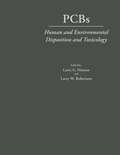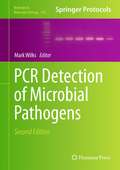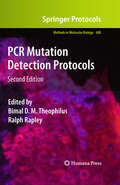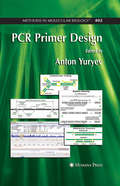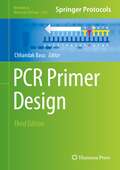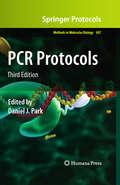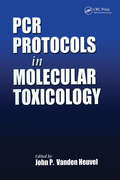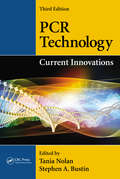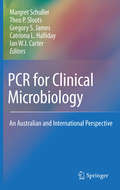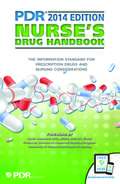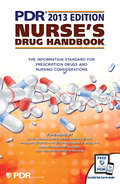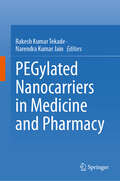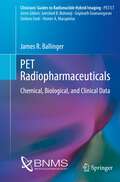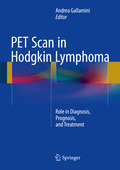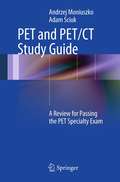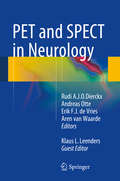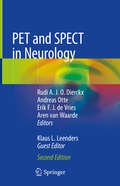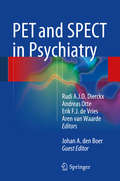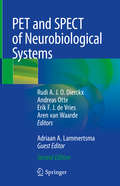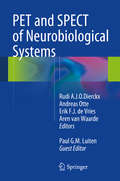- Table View
- List View
PCAT Test Prep Flash Cards: Chemistry Essentials (Exambusters PCAT Workbook #4 of 4)
by Ace Inc.<P><P><i>Advisory: Bookshare has learned that this book offers only partial accessibility. We have kept it in the collection because it is useful for some of our members. Benetech is actively working on projects to improve accessibility issues such as these.</i><P><P> 700 questions and answers. Essential definitions, formulas, concepts, and sample problems. <P><P>Topics: Introduction, Matter, Atoms, Formulas, Moles, Reactions, Elements, Periodic Table, Electrons, Chemical Bonds, Heat, Gases, Phase Changes, Solutions, Reaction Rates, Equilibrium, Acids and Bases, Oxidation and Reduction, Introduction to Organic Chemistry, Radioactivity <P>Exambusters PCAT Prep Workbooks provide comprehensive, fundamental PCAT review--one fact at a time--to prepare students to take practice PCAT tests. Each PCAT study guide focuses on one specific subject area covered on the PCAT exams. From 300 to 600 questions and answers, each volume in the PCAT series is a quick and easy, focused read. Reviewing PCAT flash cards is the first step toward more confident PCAT preparation and ultimately, higher PCAT exam scores!
PCBs: Human and Environmental Disposition and Toxicology
by Takeshi Nakano Paul S Cooke Tomas Tmovec Deborah C Rice Linda S Birnbaum Charles S WongThough polychlorinated biphenyls (PCBs) have been banned in the United States for more than thirty years, the toxic effects of their presence in local environments continue to be a significant public health concern. PCBs: Human and Environmental Disposition and Toxicology brings together more than fifty established specialists on PCB toxicity to discuss recent trends and specialized investigations of PCB influences on the environment and on humans. Renowned scientists including Paul S. Cooke, Takeshi Nakano, Tomas Trnovec, Deborah C. Rice, Linda S. Birnbaum, and Charles S. Wong present cutting-edge research on Hudson River PCBs, human contamination, homologue profiles, high PCB exposure in Slovakia, and PCB effects on the thyroid hormone, nutrition, and estrogen levels in humans and animals. Focusing on the detection, movement, metabolism, toxicity, remediation, and risk assessment of PCB contamination, this multi-disciplinary study is a valuable resource for regulatory agencies and scientists working with PCBs.
PCR Detection of Microbial Pathogens
by Mark WilksPCR methods for the detection of microbial pathogens have made relatively little impact in diagnostic microbiology laboratories due to the common decision to use expensive commercially produced tests rather than the cheaper alternative of developing one's own tests or introducing tests developed by other workers. PCR Detection of Microbial Pathogens, Second Edition presents alternatives to commercially produced PCR methods to detect microbial pathogens. Although most of the chapters in this book are devoted to the detection of specific pathogens, the first chapters in this book should appeal to anyone working in this field regardless of their particular interests. Although PCR tests can often be made to work with relatively little effort, it is often unclear how efficient the PCR test is, how inhibitory the specimen containing the pathogen of interest is and how the test can be quality controlled. All of which are of great importance in developing tests for diagnostic use. These topics are covered in great depth at the beginning of the book. The main part of the book is devoted to describing methods for the detection of a wide range of pathogens and from widely different specimens and situations. Written in the highly successful Methods in Molecular BiologyTM series format, chapters contain introductions to their respective topics, lists of the necessary materials and reagents, step-by-step, readily reproducible laboratory protocols, and notes on troubleshooting and avoiding known pitfalls. Authoritative and accessible, PCR Detection of Microbial Pathogens, Second Edition serves microbiologists regardless of their particular interest because, when used together with the general principles, the sheer variety of procedures provided here enables the reader to design and introduce diagnostic tests in the laboratory with confidence.
PCR Mutation Detection Protocols
by Ralph Rapley Bimal D. TheophilusApplication of DNA technology to the identification of disease-causing mutations has become widespread in recent years. PCR Mutation Detection Protocols, provides biological and clinical investigators with a comprehensive collection of new, recent, and updated PCR-based screening methods suitable for detecting the presence of both known and novel mutations. The methods cover point mutations (e.g., ASO-PCR, SSCP, DGGE, chemical cleavage), deletions (multiplex PCR, FISH, blotting), non-sense mutations (PTT), and more. The new and exciting techniques of DNA array analysis, along with such recently developed experimental methods as conformation-sensitive gel electrophoresis, are also included. Additional coverage is given to the direct use of DNA sequencing as a detection method in its own right and to the characterization of mutations previously located by other screening techniques. Each chapter explains the basic theory behind the technique and provides valuable notes essential for its successful execution. <P><P> Comprehensive and highly practical, PCR Mutation Detection Protocols assures both seasoned and novice investigators access to the highly productive and readily reproducible PCR-based mutation detection methods, techniques that are laying the groundwork for many of today's major scientific and medical advances.
PCR Mutation Detection Protocols, 2nd Edition
by Ralph Rapley Bimal D. TheophilusSince the publication of the popular first edition, the explosion of DNA sequence information, the access to bioinformatics and mutation databases coupled with the ability to readily detect and confirm mutations has cemented the role of molecular diagnostics in medicine and, in particular, mutation detection by the polymerase chain reaction (PCR). In PCR Mutation Detection Protocols, Second Edition, expert researchers bring the subject up-to-date with key protocols involving the PCR and its many various incarnations such as SSCP, CSGE, and dHPLC. The volume also addresses key areas such as Southern blotting, accurate diagnostics with high throughput, as well as microarray systems. Written in the highly successful Methods in Molecular Biology™ series format, chapters include brief introductions their respective topics, lists of the necessary materials and reagents, step-by-step, readily reproducible laboratory protocols, and notes which provide the often hard to find information that may mean the difference between the success and failure of the method. Authoritative and cutting-edge, PCR Mutation Detection Protocols, Second Edition aims to stimulate postgraduate scientists, researchers, and clinicians already engaged in the area and to provide an important first step for those new to this practice wanting to adopt the powerful and essential technique in their own laboratories.
PCR Primer Design
by Anton YuryevAt the heart of most high-throughput methods is the technique of polymerase chain reaction (PCR). This book focuses on primer design, which is critical to both the efficiency and the accuracy of the PCR. With intricate descriptions of basic approaches as well as specialized methods, "PCR Primer Design" is an exceptional reference for all those involved in studying the genome.
PCR Primer Design (Methods in Molecular Biology #2392)
by Chhandak BasuThis third edition provides new and updated chapters on design PCR primers for successful DNA amplification. Chapters are divided into seven parts, including primer design strategies for quantitative PCR, genotyping, multiplex PCR, in silico PCR primer design, and primer design to identify plant and animal viruses. Written in the highly successful Methods in Molecular Biology series format, chapters include introductions to their respective topics, lists of the necessary materials and reagents, step-by-step, readily reproducible laboratory protocols, and tips on troubleshooting and avoiding known pitfalls. Authoritative and easily accessible, PCR Primer Design, Third Edition aims to be useful for various fields of molecular biology, including biotechnology, molecular genetics, and recombinant DNA technology.
PCR Protocols
by Daniel J. ParkKnown for flexibility and robustness, PCR techniques continue to improve through numerous developments, including the identification of thermostable DNA polymerases which exhibit a range of properties to suit given applications. PCR Protocols, Third Edition selects recently developed tools and tricks, contributed by field-leading authors, for the significant value that they add to more generally established methods. Along with the cutting-edge methodologies, this volume describes many core applications, such as PCR cloning and sequencing, expression, copy number or methylation profile analysis, 'DNA fingerprinting', diagnostics, protein engineering, interaction screening as well as a chapter highlighting workflow considerations and contamination control, crucial for all PCR methods. Written in the highly successful Methods in Molecular BiologyTM series format, chapters include introductions to their respective topics, lists of the necessary reagents and materials, step-by-step, readily reproducible laboratory protocols, and tips on troubleshooting and avoiding known pitfalls. Authoritative and up-to-date, PCR Protocols, Third Edition seeks to further elucidate this essential technique while also providing core principles with broad applications for scientists of all backgrounds.
PCR Protocols in Molecular Toxicology (Methods in Life Sciences - Toxicology Section)
by John P. Vanden HeuvelMolecular toxicology is an emerging discipline that utilizes molecular and cell biology to understand how drugs and chemicals result in their unwanted effects. PCR Protocols in Molecular Toxicology is a practical guide to the use of polymerase chain reaction (PCR) to help examine, on a molecular and cellular level, how toxic responses are manifested. It offers a basic understanding of PCR and its optimization, as well as describing specific, high-impact areas of molecular toxicology and recent advances. The following techniques are described in detail: Quantitative reverse transcriptase PCR and methods to examine gene expression Differential display cloning Cloning and library screening by PCR Genotype and polymorphism analysis of drug and toxicant metabolizing enzymes Basic, non-PCR based molecular biology methods PCR Protocols in Molecular Toxicology will aid both novices and experienced PCR practitioners in using PCR to its fullest potential.
PCR Technology: Current Innovations, Third Edition
by Stephen A. Bustin Tania NolanPCR's simplicity as a molecular technique is, in some ways, responsible for the huge amount of innovation that surrounds it, as researchers continually think of new ways to tweak, adapt, and re-formulate concepts and applications. PCR Technology: Current Innovations, Third Edition is a collection of novel methods, insights, and points of view that
PCR for Clinical Microbiology
by Catriona L. Halliday Ian W.J. Carter Gregory S. James Margret Schuller Theo P. SlootsNot another textbook, but a valuable tool for doctors and microbiologists wanting to know how to set up a PCR diagnostic microbiology laboratory according to current regulatory standards and perform assays supplied with patient clinical diagnostic criteria and easy to follow protocols. Whether laboratories are using commercial kits or in-house methods developed in their own laboratories or adopted from published methods, all clinical microbiology laboratories need to be able to understand, critically evaluate, perform and interpret these tests according to rigorous and clinically appropriate standards and international guidelines. The cost and effort of development and evaluation of in-house tests is considerable and many laboratories do not have the resources to do so. This compendium is a vehicle to improve and maintain the clinical relevance and high quality of diagnostic PCR. It is a unique collection of; guidelines for PCR laboratory set up and quality control, test selection criteria, methods and detailed step by step protocols for a diagnostic assays in the field of molecular microbiology. The structure of the book provides the PCR fundamentals and describes the clinical aspects and diagnosis of infectious disease. This is followed by protocols divided into; bacteria, virus, fungi and parasites, and susceptibility screens. The inclusion of medical criteria and interpretation adds value to the compendium and benefits clinicians, scientists, researchers and students of clinical diagnostic microbiology
PDR Nurse's Drug Handbook
by Pdr StaffNurses are on the front line when it comes to safe medication use and counseling patients. The 2014 PDR® Nurse's Drug Handbook provides all nursing professionals, no matter what the clinical setting, with an accurate, up-to-date, and easily accessible guide to over 1,500 of the most commonly prescribed drugs. Based on the FDA-approved prescribing information, PDR's staff of pharmacists has developed concise monographs that highlight the most important information on each drug, including its approved use; dosages; interactions with other drugs, food, and alcohol; side effects; safety information; and more. Clear, straightforward nursing considerations provide guidance on proper patient assessment and monitoring, as well as patient counseling and drug administration. In addition, product comparison tables are updated for each edition, with new tables added to reflect the latest information and current practice standards.
PDR Nurse's Drug Handbook 2013
by Pdr StaffNurses are in the forefront when it comes to safe medication use and counseling patients. This new edition of PDR Nurse's Drug Handbook provides all nursing professionals in any clinical setting with an accurate, up-to-date, and easily accessible guide to the most commonly prescribed drugs - over 1,500 in this edition. Based on the FDA-approved labeling, PDR's staff of pharmacists have developed concise monographs that highlight the most important information on each drug, including its approved use, dosages, interactions with other drugs, food and alcohol, side effects, safety information, and more. In addition, clear, straightforward nursing considerations provide guidance on proper patient assessment and monitoring as well as patient counseling and drug administration.
PDR for Nonprescription Drugs 2013
by Pdr StaffThe 34th edition of PDR for Nonprescription Drugs is the most comprehensive and valuable to date. The 2013 book offers an updated guide to hundreds of the most commonly used over-the-counter medications, including analgesics, cough and cold preparations, fever reducers, allergy medications, and more. Organized for easy use, PDR for Nonprescription Drugs offers comprehensive drug information such as usage, dosage, warnings and precautions, side effects, ingredients, and more.
PEGylated Nanocarriers in Medicine and Pharmacy
by Rakesh Kumar Tekade Narendra Kumar JainThis book shelters the central principles, cutting-edge methodologies, and incipient thought processes applied to PEGylation research. The content also expounds on the critical properties of PEG and other polymers that can be applied to formulate a prolonged-circulating nanocarrier system for the delivery of gene, nucleic acid, drugs, protein, and peptide and diagnostic agents. The book summarizes the methodologies and effects of PEGylation on drug delivery and highlights recent developments in PEGylated drugs. It also aims to present vital biopharmaceutical fates of PEGylated therapeutics and examines the approaches involved in the preparation, physicochemical properties, and biological applications of long-circulating PEGylated pharmaceutical nanocarriers. This book also cross-talks and offers expert viewpoints on mucus-penetrating PEGylated nanocarrier, reversible PEGylation of nanocarriers, and Bio-PEGylation as well as PEGylation and its alternatives. The book also deals with hottopics including the current status and regulatory aspects of PEGylated Nanoproducts, and medicinal and pharmaceutical applications of PEGylated Nanocarriers. The book provides a comprehensive literature resource for the students, biologists, chemists, toxicologists, medical researchers, scientists in industries, research institutes, universities, and consultants involved in the development and testing of new advanced medicines
PET Radiopharmaceutical Business: An Insider's View
by Andrea Pecorale Maria Carmela Inzerillo Piero A. SalvadoriThe book tells the reader how a niche business can develop in a complex context and a peculiar market, such as that of PET radiopharmaceuticals. The narrative gathers three different views, and allows the reader to focus on multiple aspects that may remain hidden at the beginning of a PET radiotracer project. Nevertheless, many of the considerations in the book may be useful to approach other emerging high-tech fields of biomarkers and health indicators. The successful implementation of the Quality Assurance system is a key point of a PET organization, as well as skill identification and the selection of personnel in operational and managerial duties. The development of a GMP PET manufacturing site inside a public organization from an in-house hospital radiopharmacy and the hurdles to face and become a third party site in a public-private cooperation, are detailed and commented. Finally, the book discusses how a PET site can achieve great results despite limited resources, and what are the key strategies to choose and develop new radiotracers or ensure coexistence of multiple tracers on the market. Globally, the book provides "food for thought" and may be a valuable tool for professionals in the radiopharmaceuticals industry and managers at universities or hospital willing to develop a GMP PET Production site.
PET Radiopharmaceuticals: Chemical, Biological, and Clinical Data (Clinicians’ Guides to Radionuclide Hybrid Imaging)
by James R. BallingerThis book presents in a consistent format data on ~50 PET radiopharmaceuticals in clinical use. Parameters include basic chemical data, normal biodistribution and excretion, activity administered, radiation dosimetry, patient preparation, and clinical utility, together with a few key references. In some cases a representative image is presented. The organisation is first by clinical specialty (oncology, cardiology, neurology) and within each section by radionuclide (F-18, C-11, etc). This book will be of interest mostly to nuclear medicine physicians and trainees, but also to a wider medical community including radiologists, oncologists and radiotherapists.
PET Scan in Hodgkin Lymphoma
by Andrea GallaminiThis book describes the various contributions of positron emission tomography (PET) to the management of Hodgkin lymphoma and considers key issues in its use. A full explanation of the value of PET in disease staging and restaging is followed by discussion of its role in guiding individualized, response-adapted therapy in both early and advanced disease based on assessment of treatment sensitivity. Further chapters explore in detail the current application of PET for determination of tumor metabolic volume and planning of involved field radiotherapy. The book concludes by discussing PET scan reporting in clinical practice and the rules that have now been formally set following a number of international workshops designed to develop standard reporting criteria based on expert agreement. The authors are leading authorities who adopt an interdisciplinary approach in covering the most important aspects of the use of PET in Hodgkin lymphoma in a readily understandable way. PET Scan in Hodgkin Lymphoma will be of value to oncologists, hematologists, medical physicists, radiotherapists, and nuclear medicine specialists.
PET and PET/CT Study Guide
by Andrzej Moniuszko Adam SciukThe PET and PET/CT Study Guide presents a comprehensive review of nuclear medicine principles and concepts necessary for passing PET specialty board examinations. The practice questions and content are similar to those found on the Nuclear Medicine Technology Certification Board (NMTCB) exam, allowing test takers to maximize their chances of success. The book is organized by test sections of increasing difficulty, with over 650 multiple-choice questions covering all areas of positron emission tomography, including radiation safety; radionuclides; instrumentation and quality control; patient care; and diagnostic and therapeutic procedures. Detailed answers and explanations to the practice questions follow. Supplementary appendices include common formulas, numbers, and abbreviations, along with a glossary of terms for easy access by readers. The PET and PET/CT Study Guide is a valuable reference for nuclear medicine technologists, nuclear medicine physicians, and all other imaging professionals in need of a concise review of the basics of PET and PET/CT imaging.
PET and SPECT in Neurology
by Andreas Otte Rudi A.J.O. Dierckx Aren Waarde Erik F.J. Vries Klaus L. LeendersPET and SPECT in Neurology highlight the combined expertise of renowned authors whose dedication to the investigation of neurological disorders through nuclear medicine technology has achieved international recognition. Classical neurodegenerative disorders are discussed as well as cerebrovascular disorders, brain tumors, epilepsy, head trauma, coma, sleeping disorders and inflammatory and infectious diseases of the CNS. The latest results in nuclear brain imaging are detailed. Most chapters are written jointly by a clinical neurologist and a nuclear medicine specialist to ensure a multidisciplinary approach. This state-of-the-art compendium will be valuable not only to neurologists and radiologists/nuclear medicine specialists but also to interested general practitioners and geriatricians. It is the second volume of a trilogy on PET and SPECT imaging in the neurosciences, the other volumes covering PET and SPECT in psychiatry and in neurobiological systems.
PET and SPECT in Neurology
by Andreas Otte Erik F. J. de Vries Rudi A. J. O. Dierckx Klaus L. Leenders Aren Van WaardeThis book provides a comprehensive overview of the use of PET and SPECT in not only classic neurodegenerative disorders but also cerebrovascular disorders, brain tumors, epilepsy, head trauma, coma, sleeping disorders, and inflammatory and infectious diseases of the CNS. The new edition has been revised and updated to reflect recent advances and includes additional chapters, for example on the use of artificial intelligence and machine learning in imaging data analysis, the study of brain connectivity using PET and SPECT images, and the role of PET imaging in modulation of brain functioning by deep brain stimulation. The authors are renowned experts whose dedication to the investigation of neurological disorders through nuclear medicine technology has achieved international recognition. Most chapters are written jointly by a clinical neurologist and a nuclear medicine specialist to ensure a multidisciplinary approach. This state of the art compendium will be invaluable for neurologists and radiologists/nuclear medicine specialists and will also be informative for interested general practitioners and geriatricians. Companion volumes on PET and SPECT in psychiatry and in neurobiological systems complete a trilogy.
PET and SPECT in Psychiatry
by Andreas Otte Rudi A.J.O. Dierckx Erik F. J. de Vries Aren Waarde Johan A. den BoerPET and SPECT in Psychiatry showcases the combined expertise of renowned authors whose dedication to the investigation of psychiatric disease through nuclear medicine technology has achieved international recognition. The classical psychiatric disorders as well as other subjects - such as suicide, sleep, eating disorders, and autism - are discussed and the latest results in functional neuroimaging are detailed. Most chapters are written jointly by a clinical psychiatrist and a nuclear medicine expert to ensure a multidisciplinary approach. This state of the art compendium will be valuable to all who have an interest in the field of neuroscience, from the psychiatrist and the radiologist/nuclear medicine specialist to the interested general practitioner and cognitive psychologist. It is the first volume of a trilogy on PET and SPECT imaging in the neurosciences; other volumes will focus on PET and SPECT in neurology and PET and SPECT of neurobiological systems.
PET and SPECT in Psychiatry
by Andreas Otte Erik F. J. de Vries Rudi A. J. O. Dierckx Aren Van Waarde Iris E. SommerThis book provides a comprehensive overview of the use of PET and SPECT in the classic psychiatric disorders such as depression, bipolar disorder, anxiety disorders, and schizophrenia. In addition, it discusses the application of these functional neuroimaging techniques in a variety of other conditions, including sleep disorders, eating disorders, autism, and chronic fatigue syndrome. The new edition has been extensively revised and updated to reflect the latest advances and results in nuclear imaging within the field. Most chapters are written jointly by a clinical psychiatrist and a nuclear medicine expert to ensure a multidisciplinary approach. This state of the art compendium will be of value for all who have an interest in the field of neuroscience, from psychiatrists and radiologists/nuclear medicine specialists to interested general practitioners and cognitive psychologists. Companion volumes on the use of PET and SPECT in neurology and for the imaging of neurobiological systems complete a trilogy.
PET and SPECT of Neurobiological Systems
by Andreas Otte Erik F. J. de Vries Rudi A. J. O. Dierckx Aren Van Waarde Adriaan A. LammertsmaThis book, now in a fully updated second edition, is a comprehensive and up-to-date guide to the use of PET and SPECT for the imaging of neurobiological systems. Diverse aspects of neurotransmission in the brain are discussed, such as visualization and quantification of neuroreceptors, neuroinflammatory markers, transporters, and enzymes as well as neurotransmitter synthesis, β-amyloid deposition, cerebral blood flow, and the metabolic rate of glucose. The latest results in probe development are also detailed. A wide range of systems not addressed in the first edition are covered, reflecting the advances made in recent years. The book combines the expertise of authors internationally renowned for their dedication to the development of novel probes and techniques for the investigation of neurobiological systems. Most chapters are written jointly by radiochemists and nuclear medicine specialists to ensure a multidisciplinary approach. This state of the art compendium will be valuable to all with an interest in clinical and preclinical neuroscience. Companion volumes on the use of PET and SPECT in neurology and psychiatry complete a trilogy.
PET and SPECT of Neurobiological Systems
by Andreas Otte Aren Waarde Rudi A. J. O. Dierckx Erik F. J. Vries Paul G. M. LuitenPET and SPECT of Neurobiological Systems combine the expertise of authors internationally renowned for their dedication to the development of novel probes and techniques for the investigation of neurobiological systems. Various aspects of neurotransmission in the brain are discussed, such as visualization and quantification of neuroreceptors, neuroinflammatory markers, transporters and enzymes as well as neurotransmitter synthesis, β-amyloid deposition, cerebral blood flow and the metabolic rate of glucose. The latest results in probe development are also detailed. Most chapters are written jointly by radiochemists and nuclear medicine specialists to ensure a multidisciplinary approach. This state-of-the-art compendium will be valuable to all with an interest in the field of clinical or preclinical neuroscience. Other volumes focus on PET and SPECT in psychiatry and PET and SPECT in neurology".

